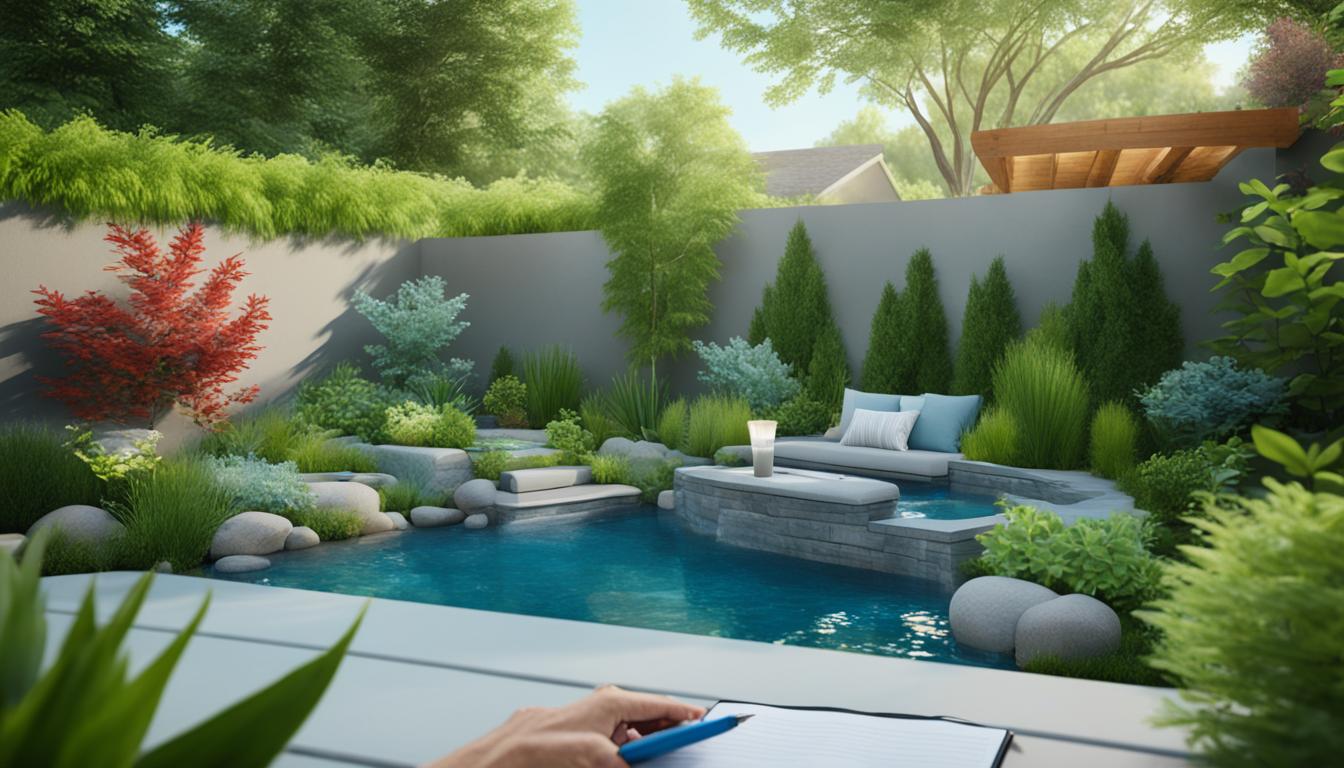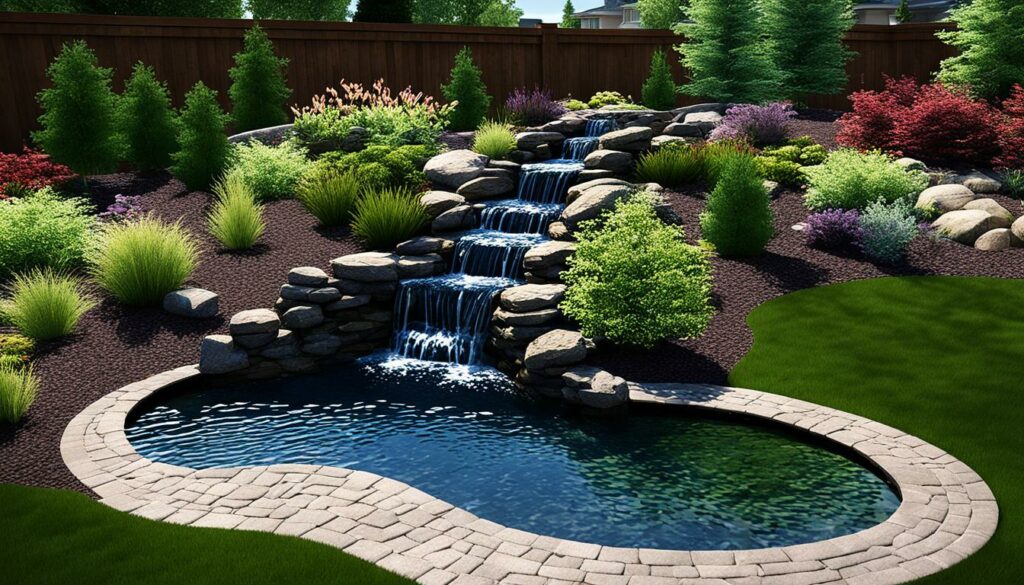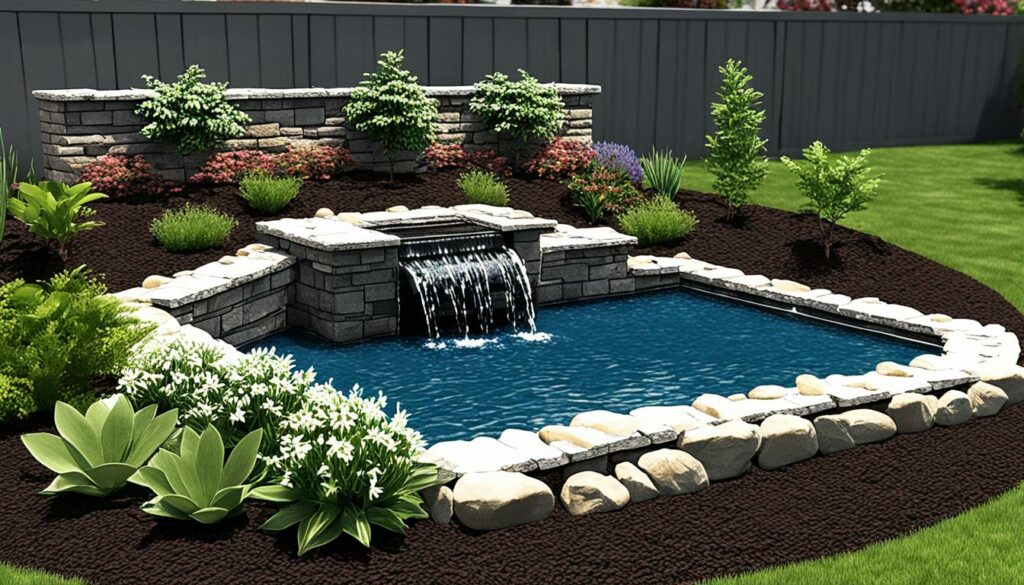
Planning a water feature project can transform your outdoor space into a tranquil and alluring retreat. The key steps in water feature planning involve assessing your landscape's potential and the overall design aesthetic to create a coherent and aesthetically pleasing addition to your yard. Professional insights can help bring your vision to life, ensuring that the beauty of nature is seamlessly integrated into your personal outdoor sanctuary.
Key Takeaways
- Transform your outdoor space into a tranquil retreat.
- Assess your landscape's potential for water feature planning.
- Incorporate a coherent design aesthetic into your garden planning.
- Leverage professional insights for an aesthetically pleasing backyard design.
- Ensure the beauty of nature is seamlessly integrated into your outdoor space.
Understanding the Basics of Water Feature Planning
Water feature planning is an exciting venture that can transform any outdoor space into a serene retreat. By understanding the types and benefits of garden water features, homeowners and landscapers can make informed decisions that align with their aesthetic preferences and practical needs. This foundational knowledge ensures that the final water feature design not only enhances the landscape but also integrates seamlessly into its surroundings.
Types of Water Features
There are various types of garden water features to consider. Naturalistic ponds, cascading waterfalls, and modern fountains each offer unique aesthetic and auditory experiences. When embarking on water feature planning, it's essential to explore all available options:
- Ponds: Natural and serene, ponds can host aquatic plants and fish, creating a lively ecosystem.
- Waterfalls: The sound of cascading water adds a tranquil ambiance to any garden.
- Fountains: Available in countless designs, fountains can be both a focal point and a subtle addition to the landscape.
Benefits of Adding a Water Feature
Incorporating a water feature into your garden comes with numerous benefits. A well-planned water feature design can elevate the entire aesthetic of your outdoor space. Here are some compelling reasons to consider adding a water feature:
- Enhanced Ambiance: The soothing sound of water positively impacts mental well-being, providing a relaxing retreat.
- Increased Property Value: Thoughtfully designed garden water features can significantly raise the value of your property.
- Ecological Benefits: Water features support local wildlife, including birds and beneficial insects, fostering a thriving garden ecosystem.
Considerations Before Getting Started
Successful water feature planning requires thoughtful consideration of several factors before breaking ground. These key points should be on every planner's checklist:
- Budget: Determine the financial scope of your project, including ongoing maintenance costs.
- Local Climate: Choose water features that suit your regional climate to ensure longevity and reduce maintenance.
- Maintenance: Assess the level of upkeep required for different types of water features.
- Ecological Impact: Prioritize sustainability and harmony with the local environment while planning your garden water features.
By integrating these considerations from the start, you ensure that your water feature design is both stunning and sustainable, providing lasting enjoyment and satisfaction.
Choosing the Right Location for Your Water Feature
Selecting the optimal site for your water feature requires thorough landscape planning and garden planning. Careful consideration ensures the feature blends seamlessly into your outdoor environment, enhancing both functionality and aesthetic appeal.

Assessing Your Landscape
To begin, assess your landscape for any steep slopes or potential obstructions. These factors can compromise the structure or aesthetics of your water feature. Proper landscape planning will help you decide on the most suitable location, ensuring that the water feature enhances your garden rather than detracts from it.
Sunlight and Shade Considerations
Considerations of sunlight exposure and shade are also crucial. These elements affect water temperature, plant growth, and overall ecosystem health. A balanced mix of sunlight and shade can create an ideal environment for both the water and the surrounding plant life. This aspect of garden planning is essential for maintaining the natural beauty and functionality of your outdoor space.
Proximity to Power Sources
Access to power sources is vital for your water feature's operational needs, such as pumps and lighting. Evaluate the proximity to electrical outlets to ensure your feature runs efficiently without requiring extensive electrical work. This step in landscape planning will save time and resources while maintaining safety.
For more comprehensive guidelines on blending custom water features into your landscape, you can refer to this ultimate guide. By integrating these elements thoughtfully, you can create a serene outdoor oasis that not only looks stunning but also functions seamlessly within your garden planning.
Designing Your Water Feature
Crafting the perfect water feature design requires a harmonious blend of natural aesthetics and manmade artistry. It's vital to reflect not only personal taste but also the architectural style of your home.
Natural vs. Manmade Designs
When deciding between natural and manmade designs, consider the overall theme of your backyard design. Natural water features seamlessly blend into the environment, offering organic shapes and materials that replicate nature's beauty. Conversely, manmade designs often boast modern structures, clean lines, and innovative materials, providing a contemporary flair.
Incorporating Landscaping Elements
Integrating landscaping elements is essential in creating a cohesive and appealing water feature design. Use stones, boulders, and plants to enhance the aesthetic and create a more immersive experience. Paths and seating areas can also be included to invite guests to enjoy the serene ambiance.
Water Plants and Wildlife Attractions
Incorporating water plants not only adds beauty but also supports local wildlife. Selecting native plants can help promote biodiversity and ecological balance. Additionally, creating habitats for birds, fish, and other critters can transform your water feature into a lively ecosystem, making your backyard design both visually and environmentally rewarding.
Steps for Building Your Water Feature
Building your water feature requires meticulous attention to detail and a structured approach. This process involves several critical steps, from gathering necessary tools and materials to executing essential tasks like site preparation and installation. Following these steps thoroughly will ensure a beautiful and functional addition to your backyard design.
Tools and Materials Needed
Gathering the right tools and materials is the first step in your water feature planning. Typically, these include:
- Shovels and digging tools
- Waterproof liners
- Water pumps
- Rocks and gravel
- PVC pipes
- Decorative elements such as fountains or statues

Digging and Preparing the Site
Once you have all the necessary materials, the next step is to prepare the site. This involves:
- Marking the outline of your water feature
- Excavating the marked area to the required depth
- Creating a level base to ensure the stability of the liner and pump
Installing the Liner and Pump
The installation phase is critical to the success of your water feature planning. Properly installing the liner and pump is crucial for functionality:
- Position the liner within the excavated site
- Smooth out any wrinkles or folds to prevent leaks
- Install the water pump following the manufacturer's instructions
- Connect the pump to the power source and test its operation
Finishing Touches and Decorations
With the basic structure in place, it's time to add the finishing touches that will elevate your backyard design. Consider the following:
- Adding rocks and gravel to conceal the liner edges
- Incorporating plants and water lilies for a natural look
- Positioning decorative elements such as fountains or statues
These final touches will transform your water feature into a stunning focal point in your backyard.
Water Feature Planning Tips and Tricks
Creating a serene and picturesque garden water feature requires careful water feature planning and meticulous attention to detail. Integrating the feature seamlessly into your landscape can amplify the overall aesthetic appeal of your garden. Here are some expert tips and tricks to guide you:
1. Assess the Site: Understanding the layout and characteristics of your garden is crucial. Consider the soil type, slope, and existing vegetation to ensure your water feature complements the natural surroundings.
2. Choose Energy-Efficient Equipment: Utilize pumps and lighting that are energy-efficient. Not only will this reduce your energy bills, but it will also have a positive impact on the environment.
3. Opt for Low-Maintenance Plants: Selecting low-maintenance plants that thrive in aquatic environments will make your water feature less labor-intensive. Examples include water lilies and lotus, which are both beautiful and easy to care for.
4. Harmonize with Nature: Whether you choose a natural or a more stylized design, make sure the water feature design blends well with your garden's existing elements. This careful integration is key to achieving a cohesive look.
5. Focus on Sustainability: Selecting materials and plants that are suited to your local climate can help create a sustainable water feature. Consider the long-term maintenance and environmental impact of your choices.
Enlisting creativity alongside these practical tips can lead to a distinctive and sustainable water feature design that enhances the beauty of your garden. By focusing on thoughtful water feature planning, you can achieve an outdoor space that is both enchanting and environmentally friendly.
Conclusion
The journey of water feature planning is a detailed yet rewarding endeavor. By thoroughly understanding the essentials, assessing your landscape, and making informed decisions about location and design, you lay a solid foundation for a successful project. Incorporating elements such as sunlight, power sources, and integrating plants and wildlife will significantly enhance the overall aesthetic and functionality of your water feature.
Throughout the process, careful attention to each phase—from designing and choosing materials to building and finalizing your water feature—ensures a seamless execution. A well-designed water feature not only beautifies your outdoor space but also serves as a tranquil retreat, adding both visual appeal and value to your property.
In conclusion, the key to a stunning water feature lies in meticulous planning and creative design. By leveraging expert advice and dedicating time to each aspect of the project, homeowners can confidently undertake their landscape planning endeavors. A well-planned water feature transforms your yard into an oasis, offering relaxation and enjoyment for many years to come.








